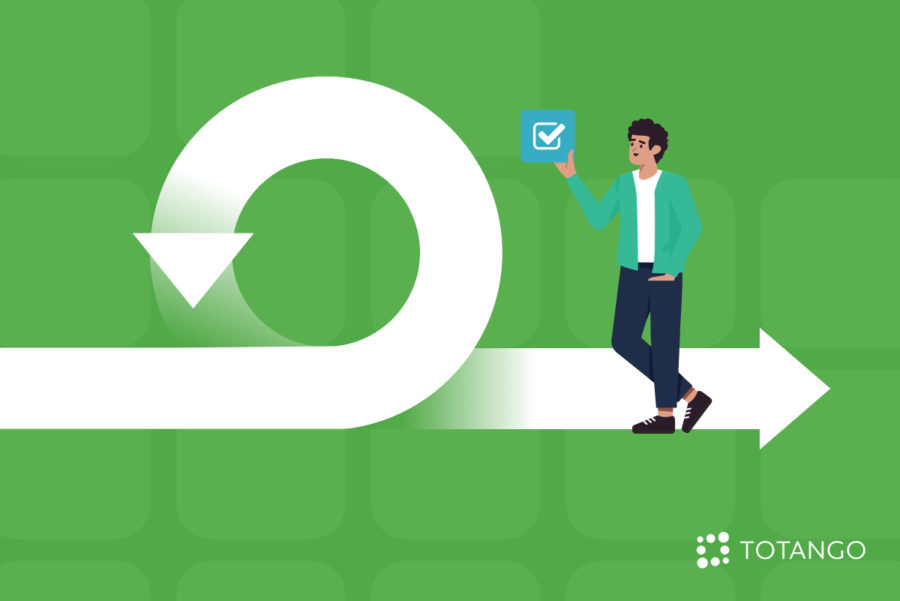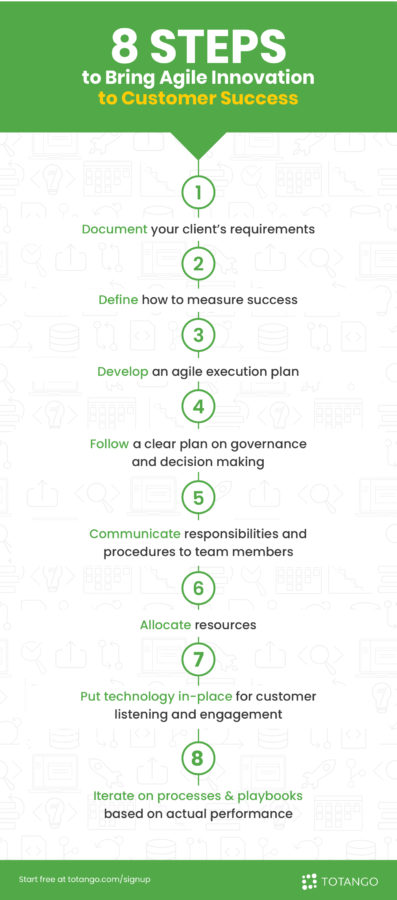When you bring agile innovation to customer success, you empower your CS strategy with the latest technology. This gains you the ability to implement CS at scale, giving you a winning edge over competitors who are still a generation or two behind in their deployment of CS automation.
In this blog, we’ll look deeper at what an agile customer success strategy means and why you can benefit from using one. Then we’ll lay out seven steps to bring agile innovation to customer success. As we unpack the elements of an agile CS strategy, we’ll highlight how to leverage the right CS technology can help you implement agility.
What Is an Agile Customer Success Strategy?
An agile customer success strategy employs a methodology of continuous, iterative, incremental improvements to achieve consistently optimized client outcomes. The agile approach is borrowed from the software development industry, where it is used to optimize collaboration between development teams and clients. When agile methodology is imported to a customer success context, it serves to optimize collaboration between success management teams and clients in order to deliver clients better outcomes aligned with their goals.
An agile CS strategy includes several key components:
- Individuals and interactions take precedence over processes and tools, with data from customer interactions informing the way processes and tools are deployed
- Improved customer collaboration follows from prioritizing individuals and interactions, a result of success teams engaging closely with customers and customer data
- Responsiveness to change results from allowing customer data to drive CS plan implementation
These characteristics make an agile approach personalized, engaging and flexible.
Why Bring Agile Innovation to Customer Success?
An agile approach enhances customer success strategies by providing a number of important benefits, including:
- Lending data-driven objectivity to customer interactions and success management
- Making CS management more responsive to real-time conditions
- Delivering more customized, personalized CS outcomes
- Making personalized customer success management scalable
These benefits give an agile approach a decisive edge over alternatives which put processes and tools ahead of customer interactions. An agile approach brings the full power of big data analytics to bear on customer success.
7 Steps to Bring Agile Innovation to Customer Success
An agile approach to CS management can be broken down into seven steps:
- Document your client’s requirements
- Define how to measure success
- Develop an agile execution plan
- Follow a clear plan on governance and decision making
- Communicate responsibilities and procedures to team members
- Allocate resources
- Put technology in place for customer listening and engagement
- Iterate on processes & playbooks based on actual performance
Let’s look closer at what each step involves and how to execute it.
1. Document Your Client’s Requirements
Effective agile CS starts with clear, documented requirements based on client engagement and input. Your customer success manager should sit down with the client to identify their needs, propose solutions, and agree upon clear objectives. Standardize your documentation approach by developing a requirements template.
2. Define How to Measure Success
Agile CS goals should be quantified in terms of measurable objectives and benchmarks. This provides transparency and accountability and empowers a data-driven approach to customer success. Use key performance indicators to define CS objectives and track progress. You can define KPIs for any stage of the customer journey, including onboarding, adoption, and expansion. Totango’s platform includes built-in KPIs and dashboards to measure and track progress toward CS goals.
3. Develop an Agile CS Execution Plan
With KPI goals defining success established, you can begin developing an agile execution plan. This should reference your KPI metrics and lay out a path to achieve each. A clear path should specify tasks to be done and who will fill the roles responsible for achieving these tasks. As with KPIs, tasks can be keyed to a customer journey map template for organizational structure and clarity.
4. Follow a Clear Plan on Governance and Decision making
Effective execution of an agile CS plan depends on following good governance and decision-making practices. Identify who will be responsible for decision-making and what their specific responsibilities are. Set up communication procedures to ensure smooth collaboration.
5. Communicate Responsibilities and Procedures to Team Members
CS management further depends on good project management. Each team member on both the internal side and the client-side needs to know what their roles and responsibilities are. Familiarize team members with standard procedures, including communications procedures.
6. Allocate Resources
The collaboration and technology required for agile CS management require a sufficient allocation of resources. This includes the allocation of personnel, time, and money. Personnel support should be made available to the extent required, but not all team members necessarily need to be dedicated to a particular account. An efficient digital-first customer success strategy that lets technology do the heavy lifting can enable you to minimize the amount of human support required per account, empowering your team to handle a larger number of accounts per support agent.
7. Put Technology In-Place for Customer Listening and Engagement
An agile approach requires suitable technology to monitor customer data in real-time for continuous adaptation to customers’ changing circumstances. To collect all available customer data, a CS solution should integrate with all relevant apps.
To meet these requirements, Totango’s platform integrates with data from virtually any data source to keep you fully advised of what’s going on with your customers. KPIs and dashboards make monitoring customer data easy. Based on what real-time data shows, Totango triggers automated and manual workflows called SuccessPlays, engaging customers wherever they are in their customer journey with actions in accord with best practices to produce optimal success outcomes.
8. Iterate on processes & playbooks based on actual performance
Agile follows the principles of Kaizen, continuous forward progress. Now that you have all of the data in front of you, you can iterate on your processes, playbooks, and messaging to ensure quality engagements that lead to retention and customer growth.
Bring Agile Innovation to Customer Success to Bring Success to Your Business
An agile CS strategy prioritizes individuals and interactions, customer collaboration, and adaptation to change. Totango’s SuccessBLOCs allow you to approach customer success in this manner by breaking up your customer journey into bite-sized chunks instead of attempting to approach the entire journey at once. This approach to CS confers multiple advantages, including data-driven objectivity, responsiveness to changing conditions, and the ability to deliver customized success outcomes at scale. Implementation of agility starts with clear requirements, measurable goals, and a well-articulated plan, and effective execution depends on good teamwork, strategic resource allocation, and smart technology usage.
Totango’s customer success platform provides the essential technology tools you need for an agile CS strategy, including KPIs and dashboards to measure and track success and automated workflows to execute your agility plan consistently. View a demo and try it free to experience for yourself how the right technology can bring agility to your CS strategy.


